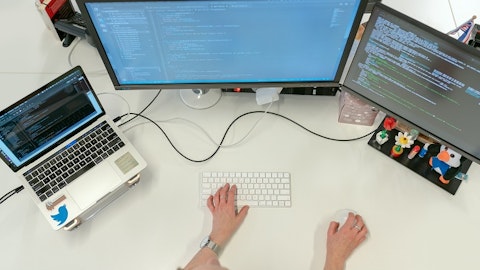Chris McGratty: Great. Thanks. Dale, the capital build in the quarter, I think the way I’m thinking about it, many thought you would build capital, some thought you build reserves. I’m interested kind of in your dynamic on how you’re thinking about building one versus the other. And could you just remind us 10% of the target, I think prior commentary is to get there by midyear. But with recent efforts and maybe some more, like any change in time line there?
Dale Gibbons: Yes. So I mean it really starts with the reserves. So we look at our loans, our exposures and overlay that with what Moody says and our own interpretation of kind of market and economic market sentiment outlook. And we drive GAAP compliance kind of seasonal number, and I realize that ratio is lower than other — some others in the space. And I think you don’t look any further than our asset quality in terms of charge-off behavior and changes in terms of kind of what’s transpired there. I mean we have — in the slide deck, we have kind of our segmentation in terms of credit protected, resistant, resilient and then the more sensitive piece. And that is just a small fraction. 1/8 of our loan book is something that we think is going to have some, perhaps, volatility.
Another measure that we look at is, I think, your ACL and divide that by annual charge-offs. And if — I mean are we — we had zero this year, but even if you took a couple of basis points on it and divide that into 60 basis points, you’re going to get 30 years charge-offs. I know this is not — this is a better than most years, but the average duration of our loan book is only is under 4%. So all sorts of ways we look at it, and we think our reserve works as is. So now it’s about what we talk about in terms of what falls down to the bottom line in terms of tangible common equity. I wouldn’t move up our time line at all. I know, I think 60 basis points is a fairly significant move for one quarter. But we’re going to do both. We’re going to grow capital, and we’re going to grow our balance sheet at the same time, sustain an improving trajectory in terms of net interest income and sustain our returns while our capital continues to climb toward the high 9s later this year.
Ken Vecchione: Chris, to be very specific, I think you can look for us to be in that capital range of 9.75% to 10%, towards the back end of the year. We got a real jump on Q4 by opportunistically selling some loans and then being able to move quickly in the EFR space. That’s our capital call and subscription line. So quite frankly, we’re pretty proud that we were able to move the capital 60 bps in one quarter, but I think you can look towards the back end of the year for those numbers.
Chris McGratty: And Ken, that’s all organically, right, there’s no more CLNs assumed in that?
Ken Vecchione: We don’t have any CLNs assumed in there and certainly no ATM either.
Operator: The next question comes from the line of David Smith with Autonomous. You may proceed.
David Smith : You share the run rate for the ECR and the deposit costs as of 12/31, what that would be on kind of a full quarter basis?
Dale Gibbons: Yes, I wouldn’t say that materially changed from where we were from for the quarterly number. It didn’t grow quite as much as maybe something anticipated because the dollars came down in terms of ECR deposits. But I think that we can track from the fourth quarter number, overlay what you think is going to happen in terms of equals actions and what you think is going to happen on the balance sheet in those particular categories. That should work. We have dollars we have in there with consequent those big.
David Smith : Okay. And in terms of the mortgage warehouse deposit book, can you share the breakdown between non-interest bearing and interest-bearing there? Is it notably different from what the mix was for the bank as a whole as of the fourth quarter?
Dale Gibbons: So most of the mortgage warehouse deposits are in DDA with an ECR, and that is the preponderance of all the ECR dollars that we have.
David Smith : Got it. Okay. And lastly, in terms of the RWA benefit that you got from the reduction in equity fund resources. Could you expand on that a little bit? I imagine that it must not be zero risk weighting. But given the kind of the risk that those loans tend to have, it must be a pretty low risk weighting, I would have thought.
Dale Gibbons: The general construct of providing a credit linked note is to provide protection, i.e., first loss taken by a third party. So we get funds in. We sell the bond to a third party, and they get that interest on that bond less any losses that are — that arise from this reference school. So on the EFR loans, these subscription lines, they’re normally 100% risk-weighted. But because we’ve done — we’ve sold a note to a third party, and they assume first loss, the first 12.5% of losses in that portfolio, they pay. And actually, we already have their money, so we control how much they get back as we only pay them back, less any losses incurred. And because of that architecture, whereby you have moved the now kind of the structured product to a AA or better category, it’s basically treated as a 20% risk-weighted asset.
So no matter what type of asset you come from, you end up at 20. So residential, you started at 50, end to 20. Capital call and warehouse, you started 100 and you still 20.
David Smith : Okay. Got it. So without the CLN though, the risk weighting is 100. Got it. It’s good to know. Thank you.
Operator: The next question comes from the line of Timur Braziler with Wells Fargo. Please proceed.





